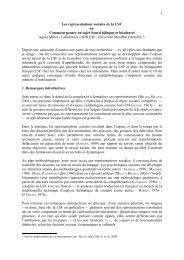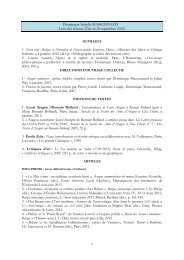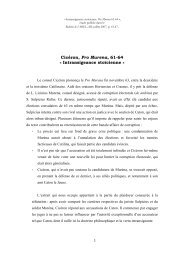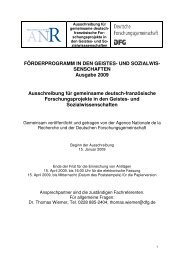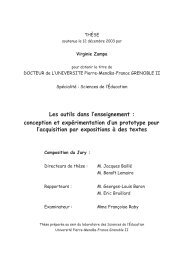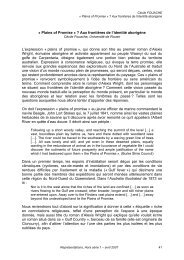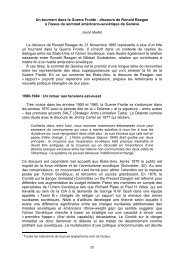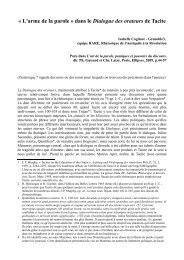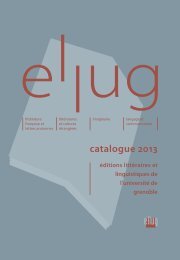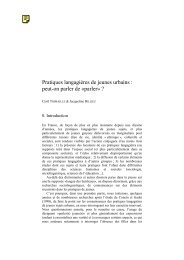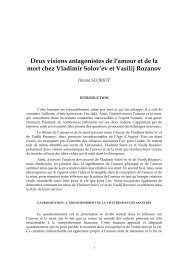Hamlet, a sixteenth century student
Hamlet, a sixteenth century student
Hamlet, a sixteenth century student
You also want an ePaper? Increase the reach of your titles
YUMPU automatically turns print PDFs into web optimized ePapers that Google loves.
All saws of books, all forms, all pressures pastThat youth and observation copied there;And thy commandment all alone shall liveWithin the book and volume of my brain,Unmix’d with baser matter: yes, by heaven!O most pernicious woman!O villain, villain, smiling damned villain!My tables, --meet it is I set it down,That one may smile, and smile, and be a villain;At least I’m sure it may be so in Denmark.[Writing]So, uncle, there you are.Here we have the good <strong>student</strong> feeding general maxims into his commonplace-book: ‘one maysmile, and smile, and be a villain’. The phrase has the paradoxical format usual to such favoritequotations of adages and sayings. Strangely, <strong>Hamlet</strong> has just been saying that he must wipe out,empty of their contents, all preceding collections of commonplaces. The reality of the world atcourt is too violent; it provides him with an accelerated course in moral science, as well aspolitical science. But scarcely emptied of its previous content, the commonplace-book begins tofill up once more, the note-taking reflex returns at a gallop. The wickedness of his uncle who haskilled his father is entered in the notebook under the heading Villainy. In order to remember thespecific case, he needs only record the general case in his ‘tables’.The word used by <strong>Hamlet</strong>, ‘tables’, indicates very precisely the material object whichforms the basis of his record of commonplaces. It is a simple little notebook. Melancthondesignates the same object in Latin by the word tabulae. In his Rhetoric of 1525, he notes that itis necessary first ‘to record in the notebooks [‘in tabulas referatur’] every maxim, adage orapothegm found in books; then these extracts are copied into the real record of commonplacesunder their appropriate heading [‘suo loco’]’ 2 . The ‘tables’ therefore are a small notebook whichcan be carried on one’s person, and the record itself is a large volume in size. Our loose-leaf file2 . In the 1527 edition, Paris: Rob. Estienne, p. 4 r : that the adolescent ‘in hic locos communes, uitiorum, uirtutum,fortunae, mortis, diuitiarum, literarum, & similes exerceat. (...) Ad hoc plurimum conducet, formas locorumcommunium diligenter notatas in manibus habere, ut si quam sententiam, si quod adagium, si quod apophthegmadignum, quod in tabulas referatur, exceperis, suo recondas loco.’3
was unknown in that era. The commonplace-books that have been found are in folios of severalhundred pages, many of which are still blank, with the key words at the top of the pages. Thesecame already bound. The pages are not scattered, precisely because the idea was to put together atreasury of quotations. Future treasure is not scattered about: the bound book is like a solidcoffer, capable of lasting. From the very beginning, it is untransportable and remains at home.The teacher requests the <strong>student</strong> to bring it in to show him once a week or every two weeks.Meanwhile, the <strong>student</strong> has at hand his ‘tables’, the little notebook in which he copies whateverstrikes him, before transferring it into his treasury.The connection between the little notebook and the large file is, of course, the wordheading. Villainy: that is what gives finality to what <strong>Hamlet</strong> is writing. Thanks to the wordheading, the uncle is locked away in the great treasury of the memory. And so we understand thecomparison of the brain with a book: it is the big commonplace-book. The brain itself is this file,this ‘table of (...) memory’’ on which to record what has first been put down in the tables. Fromtables to table. Because the quotation is indexed under the word Villainy the brain can classifyand remember it. In other words, the comparison of the brain to a book is analogous to moderncomparisons with a computer. Moreover it is no exaggeration to say that the commonplace-bookis the <strong>sixteenth</strong> <strong>century</strong>’s computer: something that is supposed to classify information and makepossible its rapid retrieval, with the same promise and the same commitment to the growth ofknowledge.Treasury or computer, we are in the world of the copia. The collection of commonplacesis intended to provide, as we have seen, a ‘rich memory of innumerable arguments’, in otherwords, a copia, an abundance of words and ideas. But the fertility may be a risk. In itself it is notnecessarily a good quality. According to the maxim highlighted by Terence Cave in hisCornucopian Text, ‘ubi uber, ibi tuber’, fertility can be a cancerous proliferation 3 . That is thepoint of <strong>Hamlet</strong>’s reference. By beginning a completely new commonplace-book, he is rejectingthe useless mass of everything with which previously he had encumbered his record. InMelancthon’s terms, the problematic is simple. Uselessness derives from a lack of ‘judgment’,i.e. a lack of critical analysis.2. Judgment or critical analysis4
Melancthon constantly repeats the principle that the practice of commonplaces forms theiudicium. Inuenire, iudicare: accumulation of commonplaces is not successful without selectionor analysis. Recopying induces thought. Either the same sentence or anecdote can be classifiedunder various headings, or the heading itself can be made more precise or explicit. For example,Cincinnatus refusing the dictatorship could be classified under the heading Agriculture (thedeputies found him working in the fields), or Old Age (the age and experience of Cincinnatus), oreven Virtue preferred to Riches. Tabourot adds:and there are other commonplaces this story could be made to fit; so that the childwill learn and retain from this research much more easily than someone simplyenjoying reading the story, and in this way he will also strengthen his judgment.The task of recopying, seemingly so rudimentary, is an intellectual exercise. For the wordheadingis in fact a concept. By recopying the <strong>student</strong> refines his concepts; and, in return, byattaching the quotation to his concept, he will better remember the quotation. One can onlyremember what has been well conceived. Hence Tabourot’s refusal to accept ‘commonplaceswhich have been collected and printed by others, as that would eventually make [the <strong>student</strong>]lazy and stupid.’ In order to be useful, the treasury has to be put together manually. Certainly thebook industry in the <strong>sixteenth</strong> <strong>century</strong> can furnish numerous ready-made treasuries, giganticthesauri. But the goal is not to assemble the largest collection. The goal is the interior mastery ofthis knowledge, to make it one’s own through memory and judgment.A word denotes this ambition. It is to ‘digest’. Technically, the verb indicates the fact ofclassifying a quotation under such and such a heading: di-gerere, that is to distribute or dispatchelements each to the appropriate pigeon-hole. The usual expression for indicating anarrangement by commonplaces is therefore ‘per locos communes digesta’, everything under itsheading. The word ‘digest’ refers to a material order, which is as well an intellectual order. Themind will better retain what it has better ‘digested’. This is the meaning of Seneca’s andErasmus’ famous image of the bee 4 . The bee gathers pollen from the flowers: the moment ofcopying the ‘flowers’ of literature and history into the portable notebooks. Back at the hive, thepollen from the flowers is distributed, each to its own place in the honeycomb: the moment of3 . The Cornucopian Text. Problems of Writing in the French Renaissance (Oxford, 1979).4 . Seneca: Epistulae, 84; Erasmus: passim.5
‘digestion’, or distribution. This, then, is how the mind makes its honey, and takes in theunfamiliar knowledge.But without judgment, the enterprise risks becoming a mere compilation. The negativeimage of digerere, is congerere: to amass for the sake of amassing, to achieve the biggest heap orcongeries possible. ‘A plentiful abundance of ideas, however great, will merely form a heap andan accumulation [‘cumulum atque congestum’], unless arrangement be employed to reduce it toorder [‘in ordinem digestas’]’ 5 . It is also the same with the accumulation of judgments andquotations. Abundance without order is of no use, it is even worse than useless. The more oneaccumulates, the less one thinks and the less one ‘judges’.Clearly the risk of pure compilation threatens the entire undertaking of collectingcommonplaces. Here Melancthon is seen at his liveliest, in his firm opposition to the methodpraised by Erasmus. The latter, in his famous De Copia (1512), is already proposing a method forcollecting exempla that is none other than that of commonplaces. But De Copia is caught in thetemptation and intoxication of overabundance, ubi uber, ibi tuber. The fertile pen and immensereading of Erasmus lead him to accumulate a whole series of maxims under a single heading. Hehimself remarks that it is a ‘disorganized mass [‘indigesta turba’]’. In order to prevent thecreation of anarchy, confusio by such a mass, he suggests ‘dividing the rather too rich headingsinto a number of sections [‘secare in aliquot partes’]’:For example, the heading ‘Liberality’ could be divided into parts [‘partiri’] withthe following sub-sections: Gift quickly given, Appropriate Gift, Gift given tosomeone who is deserving, Blameworthy Gift, Reciprocal Gift. Or other subsectionsdeemed fitting, for these are only mentioned to serve as examples... 6The ‘method’ of Erasmus is obviously very empirical. It falls to each person to ‘judge’ accordingto the examples, and find appropriate sub-sections. But no guidance is given as to the order to befollowed. The abundance is checked rather than controlled by an order. Moreover, the order isnot particularly important, given the degree to which Erasmus originally tries to develop the tastefor maxims and anecdotes.As for Melancthon, he is much more systematic, because he is much more concerned withthe formation of judgment. He banishes an alphabetical order that is too disjointed or arbitrary.5 . Quintilian, Institutio oratoria, VII, Prol., 1, ed. H. Butler (Cambridge, 1986, ‘Loeb’) - translation slightly altered.6 . De Copia, ed. Knott (Amsterdam, 1991), 1-6, p. 260, 1. 578-583 (=LB 101).6
He prefers a rational order in which everything is arranged according to the ramifications ofknowledge. The latter is organized like those trees in the image of the encyclopedia. The mainbranches are the major disciplines: philosophy, law, history and theology. Each branch bears itsown headings or commonplaces, which are not enumerated in bulk, but according to an order ofreasons. If for example one of Melancthon’s lists put Temerity and Temperance close together, asin Tabourot’s, it is purely by accident, for his list is: … Fortitudo Constantia TemeritasTemperantia Sobrietas Ebrietas Crapula Libido Castitas... 7 . What matters here is the ‘natural’order of the virtues, which are in themselves grouped by opposites. The memorization ofnumerous examples under such headings implies memorizing the complete list of that branch ofknowledge known as ethics or moral science. Finally, if a heading is too rich, its sub-sectionsobey the same principle of systematic ordering. It will be organized according to the samedialectics, beginning, as always, with the definition, followed by the cause, and then by thespecies, etc.:Take for example the debate ‘Are ideas the cause of things?’. It cannot be decidedunless one first knows what is an idea. And one cannot know what an idea is,unless the headings have been organized according to the method which beginswith the question what is it? 8Thus we arrive at the reverse of Erasmus’ empiricism. Melancthon’s systematic assumes atrained judgment, a strong conceptual capacity: ‘commonplaces cannot be correctly understoodunless each of the disciplines from which they originate is itself perfectly understood.’ 9 The greattreasury is possible only if it is organized like an encyclopedia.Opposition to Erasmus’ less methodical method finds expression in Melancthon in theopposition of two words: partition or division, partitio, diuisio. According to Cicero’s terms inTopics (#28), partition is a definition of the enumeration of ‘what one might call the members’ ofthe concept to be defined: ‘civil law as composed of statutes, decrees of the Senate, judicialdecisions’, etc. Division, however, is a definition by analysis ‘which includes all the species[‘formae’] that come under the genre [‘genus’] which is being defined.’ Clearly Melancthonleans towards the division into species whereas Erasmus, in the text quoted from De copia is onlyconsidering the division into partes. One of the proofs of this lies in Melancthon’s definition of7 . De rhetorica of 1521, Ch. VIII.8 . De rhetorica of 1519.7
commonplaces as ‘formae rerum’, in other words ‘species’ into which ‘things’ can be sorted. InMelancthon’s eyes, the advantage of division is emphasized by Cicero himself. In fact, ‘on theone hand there is a fixed number of species which are included in each genus; on the other hand adistribution into parts is often almost limitless’ (Topics, 33) 10 . On the one hand is the closedworld of knowledge, divided into genres and species; and on the other the open world ofappearances and anecdotes. Melancthon compared to Erasmus is like Aristotle compared toProteus.Thus Melancthon’s method is completely consistent with the distributive prefix di- of theword ‘digestion’. ‘Di-vision’ precedes the work of classification or distribution. Analysis refinesthe allocations between related species and sub-species, in order to obtain a ‘di-chotomy’ withmany branches. This is visually represented by the famous tables of Ramus, Melancthon’s heir.Classification is followed by the work of ‘dis-position’. The prevailing order in the commonplacebook is a prelude to the order which will prevail in the actual thesis, in the finished product. If, onthe other hand, Erasmus’ superabundance prevails in the commonplace book, the thesis will alsobe a catch-all, a heap of maxims and ‘flowers’. The taste for a flowery style will outwin thelogical scheme.All of which brings us back to <strong>Hamlet</strong>. For the rancor between the followers ofMelancthon and the followers of Erasmus is found again in the opposition between <strong>Hamlet</strong> andthe courtier Osric (<strong>Hamlet</strong>, V, 2). The latter describes Laertes in an almost incomprehensiblestream of flowery terms and expressions. According to Osric, Laertes is a complete gentleman,he is the card or calendar of gentry, for you shall find in him the continent of whatpart a gentleman would see.<strong>Hamlet</strong> replies in Melancthon terms of definition and division. His derision is perhaps promptedby Osric’s word ‘part’, which might remind him of the opposition partitio/diuisio:Sir, his definement suffers no perdition in you; though, I know, to divide himinventorially would dizzy the arithmetic of memory.To make a true Melancthonian diuisio of Laertes, to define him according to the rules of inuentio(‘inventorially’), and thus assist memorization, judgment or iudicium is needed. <strong>Hamlet</strong> does notconsider Osric has that judgment, that Cartesian ‘bon sens’ or good judgment. In his estimation9 . Elementa rhetorices, Corpus Reformatorum, XIII, col. 452.10 . Topica, ed. H. Hubbell (Cambridge, 1976, ‘Loeb’) - translation slightly altered.8
he is merely a store of expressions: once ‘his purse is empty’, he can no longer say anythingbecause he has spent all his ‘golden words’. In other words the contents of the commonplacebookare already lopsided, because they lack both ‘digestion’ and ‘division’.The irony is continued in what immediately follows. It is still a question of definition, andtherefore of lack of judgment. Osric praises Laertes’ prowess in fighting. <strong>Hamlet</strong> asks him‘What’s his weapon?’ to which Osric replies: ‘Rapier and dagger’. A fine example of conceptualconfusion which <strong>Hamlet</strong> hastens to underline: ‘That’s two of his weapons, but, well.’ Osric goeson to enumerate, an endless partitio. The king has in fact wagered six Barbary horses against sixFrench rapiers and poniards, with an eager listing of all their accoutrements, including carriages.<strong>Hamlet</strong>: ‘What call you the carriages?’; Osric: ‘The carriages, sir, are the hangers.’ The list orpartitio results in the use of unsuitable words for lack of definition. The carriage (gun-carriage)is in fact either a vehicle used in transportation or the mounting that allows the cannon to bemaneuvered. As <strong>Hamlet</strong> points out, the word would be appropriate ‘if we could carry a cannon byour sides’. Enumeration, carelessness in definition: all of this confirms that Osric, is, even in hisstyle, the incarnation of what <strong>Hamlet</strong> has learned to detest. It is not only the black <strong>student</strong> gownthat <strong>Hamlet</strong> brings with him from Wittenberg, but also the severity of mind. <strong>Hamlet</strong> is theantithesis of the flowery manners of courtiers at the end of the <strong>century</strong>. They know how to handlethis rhetoric which Melancthon, following Socrates theme in the Gorgias (463a), calls ‘asubsection of the art of flattery’.. 3. That is the quaestioIn this game of opposites, Osric is most certainly caricatured as a typical courtier. But<strong>Hamlet</strong> does not go unscathed. He is typified as a <strong>student</strong>. His style is no less distinct than hisblack clothes. It would seem that a spectator in those days who had been taught the commonplacemethod would find it rather amusing when, on the departure of the ghost, <strong>Hamlet</strong> takes out hisnotebook. Even after the shock of the revelation of the murder, the good <strong>student</strong> remains a good<strong>student</strong>, conscientiously applying the method he has been taught. Later on, that most famousverse, ‘To be, or not to be, that is the question’ (III, 1, 56), is, again, a quite typical utterance,with a strong academic flavour. First I shall analyze the second part of the verse, beforepresenting my hypothesis for the meaning of ‘to be’.9
In the first place, the word question can only mean the quaestio.There can be no possibledoubt about this. It is the quaestio disputata, the dispute of university teaching: a debate of forand against. Sixteenth <strong>century</strong> humanists would have found its Greek equivalent in Quintilian orCicero, i.e the ‘thesis’. Whether in debate or dissertation, the thesis is an exercise for advanced<strong>student</strong>s, the equivalent of a final exam. In <strong>Hamlet</strong>, the text immediately following is enough toindicate the debate. Whether/or is the equivalent of the Latin -ne/an:Whether ‘tis nobler in the mind to sufferThe slings and arrows of outrageous fortune,Or to take arms against a sea of troubles,and by opposing end them.Either submit, or else revolt. The debate then bears on the action, on the question of knowingwhether one should act or not: ‘action’ is the last word of the tirade.In the passage from De Copia quoted above, Erasmus gives several examples expressedin exactly the same format as <strong>Hamlet</strong>’s. He calls them ‘comparatiua’:‘Is one happier celibate or married?’, ‘a private life, or not?’, ‘rather the monarchythan the democracy?’, ‘the life of the learned or the ignorant?’ [‘Coelibatusnefelicior, an coniugium?, uita priuata, an secus?, potior monarchia, andemocratia?, uita studiosorum, an idiotarum?’] 11It is the same use of the comparative. In <strong>Hamlet</strong>, it is what is nobler; in Erasmus, it is what makesone happier, felicior. This similarity of examples enables us to identify exactly the dissertationwith which <strong>Hamlet</strong> is dealing.Technically speaking, it is a practical, comparative thesis, as shown by the followingdivision (a Melancthonian or rather Platonic division):QUAESTIOfinita (= hypothesis)/ \vs. INFINITA (= thesis)/ \speculativevs. PRACTICAL/ \non-comparative vs. COMPARATIVE10
I will explain first what ‘practical’ and ‘comparative’ mean. Only then will we return to thedistinction between thesis and hypothesis.As for the ‘practical’ thesis, the distinction between the speculative and the practicaltheses is in Cicero’s terms scientia vs. actio (Quintilian, III, 5, 6-13). The speculative belong topure philosophy of the kind ‘Is the world ruled by providence or not?’. The practical bear on anaction to be undertaken or not, such as ‘Should one get married? Should one participate in publicaffairs?’. Even when these practical theses are discussed in the abstract, they clearly result inobvious indications for action. Cato could not have decided that he should marry Marcia, had henot previously decided that a philosopher should marry.<strong>Hamlet</strong>’s quaestio therefore is practical, its goal is actio. Again, there are two kinds ofpractical theses, the comparative and the non-comparative (Quintilian, II, 4, 24). The formerare concerned with the comparison of one thing with another [‘ex rerumcomparatione’], for example, ‘which is preferable, town or country life?’ or‘which deserves the greatest praise, the lawyer or the soldier?’ [‘rusticane uita anurbana potior’, ‘iuris periti an militaris uiri laus maior’] 12To this first kind of thesis - the comparative one - Quintilian adds a second, the non-comparative,defined only by examples: ‘should one take a woman? Should one solicit public duties?’. Hestates that these non-comparative theses ‘relate almost uniquely to the deliberative genre’, they infact relate to an action to be undertaken or not. If a person’s name is added to such a noncomparativethesis, it would become a ‘suasoria’: a speech that incites action. Quintilian does notsay explicitly that the comparative thesis itself incites action as well. But the context of this verybrief paragraph shows he simply wants to stress that the form ‘Should one do this or that?’ ismore directly related to an action to be taken, whilst the comparative form is as it were moremediatory, hence more speculative. If it results from the discussion that country life is preferableto that of the city, this would indeed imply that the discussion results in a choice of action. Thislittle problem is especially interesting in relation to <strong>Hamlet</strong>. Ultimately, these two kinds of theses11 . Amsterdam edition, p. 260, 1. 569-571 (= LB 101).12 . II, 4, 24, ed. H. Butler, translation slightly altered. The ‘comparison drawn from things’ is compared inQuintilian to a ‘comparison’ that is familiar to us, the comparatio or parallel between famous men, comparatiouirorum et non rerum (II, 4, 21). The Greek orator Aphthonios isolates this exercise under the title of synkrisis orcomparatio and gives as example the parallel Achilles-Hector. His Progymnasmata in Latin are one of the basicmanuals of literary studies of the <strong>sixteenth</strong> and seventeenth centuries, all over Europe.11
are only different in the way they are presented, ‘to take a woman, or not’ compared with ‘to becelibate or married’. ‘Either submit or revolt’ is a comparative thesis. ‘To submit or not’ is not.Clearly <strong>Hamlet</strong> superimposes the two formulations, and precedes the comparative with a noncomparative.‘To be, or not to be’ , a non-comparative thesis, is the same in advance as ‘eithersubmit or revolt’, a comparative thesis. 13Whether speculative or practical, comparative or not, before these two divisions we mustdistinguish between the thesis and ‘the hypothesis’. In other words, the quaestio argued by<strong>Hamlet</strong> is, primarily, like every thesis, a quaestio infinita. There are actually two kinds ofquestions, as summarized by Quintilian in III, 5, 5-15. The quaestio finita is a debate centered ona specific case, determined or finitus. The quaestio infinita centers on the case in general. ‘ShouldCato marry Marcia, or not?’ is a quaestio finita or ‘hypothesis’, where the individual isspecified 14 . ‘Should the philosopher marry, or not’ is a quaestio infinita or ‘thesis’. Anotherexample, taken from Cicero in De Oratore (III, 109). The specific question is ‘Should we recoverour prisoners from the Carthaginians by giving them back theirs?’, and the general question: ‘Inprinciple, what should be the decision and thought concerning prisoners of war?’. This movementof referring the particular back to the general is at the very heart of the great Ciceronianeloquence, as Melancthon saw so clearly. And so it is not accidental if under commonplaceheadings, it is general formulations, infinitae, which are accumulated, providing material fordebates which are themselves general. We have seen it in what <strong>Hamlet</strong> writes in his tablets. ‘Onemay smile, and smile, and be a villain,’ being the general case. ‘At least I’m sure it may be so in13 . ‘In the universities, (…) the <strong>student</strong> beyond his second year became a “sophister” and was required to take partin a state number of disputations, both in college and in public (…). Undergraduates in their third or fourth year andfor their baccalaureate degrees often treated philosophical questions. For the MA the questions could become timely:“whether a college education will get you ahead in politics, (…) whether women should have a liberal education,(…) [whether] the power of the sword is the prince’s alone, (…) [whether] All change in the commonwealth isdangerous” [typical non-comparative theses, quoted from Craig R. Thompson, Universities in Tudor England(Washington D.C., 1959, p. 27)]. When Elizabeth I visited Cambridge in 1564, she heard public disputations onpropositions that were topical, current, indeed quite close to Elizabeth herself: whether the authority of Scripture isbetter than the authority of the Church [= comparative thesis], and whether the Civil Magistrate has authority inmatters ecclesiastical [= non-comparative thesis]. (…) It is a reminder that disputation was a prominent educationalactivity in that year of Shakespeare’s birth - and remained so, at least through the age of Milton.’ (Thomas O.Sloane, ‘Rhetorical Education and Two-Sided Argument’, Renaissance-Rhetorik, Renaissance Rhetoric, ed.Heinrich F. Plett, New York and Berlin, 1993, 163-178, here p. 170; Sloane shows that Erasmus’ Encomiummatrimonii is giving the pros and cons of the question ‘should one marry’)14 . To be architypical, the question asked of Cato is in fact quite specific. The great orator Hortensius ‘not being ableto marry Porcia, Cato’s daughter, demands of that same Cato that he divorces his wife Marcia; Cato agrees to it withhis father-in-law’s approval, and Marcia lived with Hortensius from the year 56 to 50, at which date, since12
Denmark’: being the specific case. ‘So, uncle, there you are’: the uncle is the specific case whichmakes it possible to arrive at a general truth, which is written under a heading.‘That is the question’: with this <strong>Hamlet</strong> launches a general debate, a quaestio infinita. Atno point in the tirade that follows does one actually find any other formulation that theindeterminate: the argument is about ‘us’ not ‘me’ 15 . <strong>Hamlet</strong> is reasoning in general, generaliter,on the level of principles, in order to know what to do in this specific case. This, once again,reveals him as a typical <strong>student</strong>. Instead of acting he discusses action. The more he disputat, theless he decides. Such a typical attitude is in fact a cliché. For a spectator of those days it refers tothe typical vice of the melancholy temperament. The sanguine is the man of action, the greatcaptain, the Prince. The melancholic is the intellectual, ‘the man of genius’ according toAristotle, the Philosopher. <strong>Hamlet</strong> is melancholic, and a prince as well. The more philosopher hebecomes, the less he is a prince. If then he is a typical <strong>student</strong>, if there is a – slight - touch ofcomedy, then there is also tragedy. It is the tragedy of a world where the Platonic ideal of thephilosopher-prince is doomed to failure. Of what use is the University?The extremely important opposition between the specific and the general case enables usto conclude by suggesting an alternative interpretation of the words ‘to be, or not to be’.Implicitly ‘to be’ is usually understood to mean to live, and ‘not to be’, not exist, i.e. to die. Thesentence that immediately follows would seem to confirm it, ‘To die: to sleep’ which would seemto be a repetition of ‘not to be’. But dying in this case immediately follows the idea of revolt.Death is considered in relation to the fact of taking up arms against the new king, or rather of notdoing so. <strong>Hamlet</strong>, certainly, is arguing in general about death, about the fact that it ‘puzzles thewill’, and makes us bear the ills we have: the idea of death kills that of revolt. But in my opinionhe does not think of suicide, at least at the beginning of the soliloquy. Such an idea stems fromthe assumption that ‘not to be’ means ‘to die’.‘Not to be’: such an expression sounds - if I dare say so - like pidgin English. It isacademic jargon. In other words, this bizarre sentence seems to refer back to the strangeness thatcharacterizes <strong>Hamlet</strong>: to his situation as a <strong>student</strong>. Once we accept that the ‘question’ in the textis the quaestio, we then become aware of the importance of the ‘or’ and of the opposition. It isHortensius was dead, the virtuous Cato took her back with the fortune left to her by the great orator’ (Jean Cousin, anote in his edition of Quintilian’s Institutio oratoria, Paris, 1977, p. 267).15 . This point is emphasized in Harold Jenkins’ edition of <strong>Hamlet</strong> (London and New York, ‘The ArdenShakespeare’, 1982), ad loc., p. 486.13
clearly parallel to the motion ‘whether/or’ in the following sentence. Whether to submit, or notsubmit; or else marry or not marry. Or indeed be or not be. If we now think about the distinctionthat was then evident between quaestio finita and quaestio infinita, I believe we find the key. Forthe basic principle is always to go from the specific to the general. From the uncle of Denmark tothe smiling villain. From the prisoners of Carthage to a debate of the principle concerning theattitude to be taken in such a case. Melancthon has remembered Cicero’s teaching. To giveeloquence its lustre, this is the way in which one should philosophize:The most ornate speeches are those which (...) turn aside from the particularmatter in dispute to engage in an explanation of the meaning of the general issue,so as to enable the audience to base their verdict in regard to the particular partiesand charges and actions in question on a knowledge of the nature and character ofthe matter as a whole. 16This, in the final analysis, is the source of interest in the commonplaces: to be able to speakgeneraliter. One goes from the particular to the general, or, as we say today, one ‘elevates’ thedebate by discussing a question of principle, beyond specific circumstances.In oscillating between ‘to be’ and ‘not to be’, it seems to me that <strong>Hamlet</strong> pushes to thelimit this movement of elevation from the concrete to the abstract. The first abstraction goes from‘should I submit’ to ‘should one submit’, by abstraction from the specific self. From this generalcase, <strong>Hamlet</strong> will move back to an even more general formulation, by passing over the elementthat can still be removed, that is to say the predicate ‘submissive’. To be, or not to be submissive;to be, or not to be in rebellion, according to the way every sentence is analyzed by medievallogic, where to walk becomes to be walking and to live, to be living. One more step and ‘to be, ornot be submitted’ becomes ‘to be, or not to be’. The strangeness of the sentence results from itsradically abstract quality. The process of abstraction has been pushed to its limit. To give it fullemphasis, one could translate the famous verse in terms of modern and not scholastic logicalabstraction: ‘To be x or not be x, that is the way in which the discussion presents itself’. Or: ‘Thedebate fundamentally takes an either/or form’ 17 . <strong>Hamlet</strong> launches his general reflection byframing it in an abstract format which he knows and finds reassuring, in order to clarify aconcrete situation which eludes and troubles him. The good <strong>student</strong> is thus exceptionally gifted in16 . De Oratore, III, 120, ed. H. Rackham (Cambridge, 1960, ‘Loeb’).14
abstraction, he has understood from within the movement that supports the commonplacemethod.If ‘not to be’ does not mean to die, the very idea of suicide becomes problematic. Yet thecritics are probably right when they unanimously feel that <strong>Hamlet</strong> in this tirade is in a suicidalmood. I will argue that the idea of suicide is not and cannot be explicit, and certainly not at thevery beginning of the tirade. It comes insidiously, as a drowning, or more justly as a sleep. Themore <strong>Hamlet</strong> tries to clarify the situation by reasoning, the more he sinks.In other words, according to my presentation, <strong>Hamlet</strong>’s anguish comes directly from hisbalancing between two opposite actions, or rather between action and inaction, revolt against thenew king or submission to his new order. <strong>Hamlet</strong> is anguished because he wants to decide, andaltogether cannot decide. And it is this very impossibility to decide that gives to the whole tiradeits suicidal tone. When he equates to die and to sleep, he plays more or less consciously with anidea like the glorious death of the rebel: taking up arms against his uncle would be a classic role,Brutus against tyranny. His explicit reasoning is: since to die is to sleep, why should I be afraidof taking up arms? But the curious result of the discussion or quaestio is that eventually <strong>Hamlet</strong>is unable to decide, to make up his mind. Therefore the equation ‘to die: to sleep’ sounds quitedifferently. The very idea of death as sleep is like a way to anticipate the absence of decision,such an absence being itself the sleep of reason. The more <strong>Hamlet</strong> discusses explicitly withhimself, the more he sinks, implicitly, into indecision, as one sinks into sleep. He does not evendecide to choose inaction (submission): inaction merely comes from his indecision. Such adescription is indeed the description of a suicide to come. Suicide is around the corner, but not inan explicit way, and certainly not at the beginning of the soliloquy. <strong>Hamlet</strong> is very far from beingsome stoic hero, facing and discussing the idea of committing suicide.There is no such a thing as a clear decision to commit suicide, precisely because duringthe tirade <strong>Hamlet</strong> comes to understand that he cannot reach any decision. Suicide is not theofficial topic of the discussion. On the contrary, my point is that the academic form of thequaestio is a desperate attempt to escape suicide - an attempt that fails.An other way to put it would be to refer again to the concept of judgment. <strong>Hamlet</strong>’scontinuing indecision shows that he lacks iudicium. This is the height of failure for a follower of17 Cf. the parodic use of the famous verse, e.g. ‘to be drunk, or not to be drunk’, ‘to be elected, or not to be elected’,etc.: any predicate can be used, the verse is like an empty container indefinitely reusable.15
Melancthon. Ideally, <strong>Hamlet</strong> should use his iudicium at two levels: first by deciding the questionfrom an abstract point of view (in general, should one revolt or not), and then determining theconcrete correct balance in the case at hand. For this lack of judgment is also a failure in theworld of Aristotelian ethics. In this world, determining the exact balance in every concrete case isthe meson, the golden mean between two extremes. It is virtue at its peak, not mediocrity. Andsince it is excruciatingly difficult, it is the monopoly of great princes or politicians: of the‘prudent’ men. For someone who, like <strong>Hamlet</strong>, is intelligent and a prince, it is a double failure, asa Melancthonian <strong>student</strong> and as an Aristotelian prince. The possibility of such a failure is asufficient cause for a major anguish. With his indecision, <strong>Hamlet</strong> finally rejects the ethicalAristotelian scheme, as he rejects the revenge scheme of the ghost. He does not fit in the schemesthe world would want him to adopt. 18 This, I am afraid, is again an old cliché on <strong>student</strong>s,describing their way of rejecting clichés and conformism.*To conclude, <strong>Hamlet</strong>’s powerful intelligence is both his greatness and his weakness. Hehas more talent for abstraction than for action. Similarly he has a greater gift for defining andanalyzing, whereas Osric is gifted at enfolding everything in flowery words. Finally, <strong>Hamlet</strong>knows how to memorize, but not to the point that he can avenge his father, which is what wasdemanded by the ‘Remember me’. His logic and that of the world are incompatible. As a blackrobed<strong>student</strong> of the <strong>sixteenth</strong> <strong>century</strong>, his style is outmoded, or at least his manners are out ofplace. If what he has learned at the university is of no use to him in ruling the court, is because hehas after all been taught a worthless method. He is a model <strong>student</strong> and thus demonstrates thelimits of the model he is following. And I believe this is why his features are recognizable to his18 The case <strong>Hamlet</strong> is facing is a case in courage, and his lack of judgment or prudence means that he is lacking thevirtue of courage. Jenkins (p. 490) notes accurately that <strong>Hamlet</strong> cannot seriously consider ending the ‘sea oftroubles’ by opposing them with weapons. In this case, it would unquestionably be more noble to take up arms thanto do nothing, so there would be no reason for debate, for quaestio. I would add two remarks. (1) The word‘troubles’ in <strong>sixteenth</strong> <strong>century</strong> vocabulary usually refers to the totality of a political situation, e.g. the ‘religioustroubles’. It is not a question, as Jenkins says, of ‘his troubles’, of <strong>Hamlet</strong>’s personal troubles, but rather of thegeneral confusion which seems to him to have taken over the kingdom. (2) To claim to conquer a ‘sea’, according toAristotle, is not really courageous: the Celts struggling against the waves for him is an example of the lack ofcourage due to the lack of fear (Eth.Nic., III, 7, 1115b25; Eth.Eud., III, 1, 1229b28). What <strong>Hamlet</strong> has to decide isthe due mean, i.e the precise attitude to maintain between this lack of fear and the lack of courage, which would be16
contemporary audience. He can be seen as almost as typical a character as Osric. His values as a<strong>student</strong> of Melancthon are not necessarily acceptable to the public.If we step back a little from the character, we gain a point of view similar to the radicalcritique of the ‘commonplace’ method in seventeenth-<strong>century</strong> France. Descartes will make aclean sweep of the notebooks and the Cornucopiae. Arnauld and Nicole will explicitly deny thatcommonplaces can form judgment, in other words Cartesian ‘common sense’. But, conversely,what is lost with Descartes is the sharp sense of tragic - and comic - complexity of humansituations. Not tabula rasa, not tabula plena. Shakespeare is working with a table that is stillpiled astonishingly high with the maxims and anecdotes supplied by his political experience.<strong>Hamlet</strong>’s abstraction, from this point of view, is not a mathematical or logical abstraction. It is anattempt to control rather than suppress the political complexity. Such an attempt fully deservedan appropriate method 19 .Université Stendhal (Grenoble-III)needed to put up with such a situation, i.e. oppression by his uncle’s tyranny (‘Th’oppressor’s wrong’, v.71). Truevirtue, in this case the virtue of courage, rests only in the precise balance between these two extremes.19 . For a critique of the Cartesian method as it relates to the complexity of state affairs, one would do well to readthe De nostri temporis studiorum ratione oratio (1708) by Giambattista Vico. Vico criticizes the Cartesians preciselyfor having undone the link between ‘topic’ and ‘analysis’, between inuentio and iudicium, and totally favouring thelatter.17
* This article is an enlarged version, translated by Yvonne Freccero, of ‘<strong>Hamlet</strong>, étudiant duXVIe siècle’, Poétique, 113 (1998), 3-15, with the kind authorization of Les éditions du Seuil(Paris).1 . Tabourot des Accords, Les Bigarrures, IV, 1, Paris: Jean Richer, 1585. For a more extensivediscussion of the commonplace method, see Ann Blair, The Theater of Nature. Jean Bodin andRenaissance Science (Princeton, 1997); Marie-Dominique Couzinet, Histoire et méthode à laRenaissance. Une lecture de la Methodus de Jean Bodin (Paris, 1996); Francis Goyet, Le sublimedu ‘lieu commun’. L’invention rhétorique dans l’Antiquité et à la Renaissance (Paris, 1996); AnnMoss, Printed Commonplace-Books and the Structuring of Renaissance Thought (Oxford, 1996).2 . In the 1527 edition, Paris: Rob. Estienne, p. 4 r : that the adolescent ‘in hic locos communes,uitiorum, uirtutum, fortunae, mortis, diuitiarum, literarum, & similes exerceat. (...) Ad hocplurimum conducet, formas locorum communium diligenter notatas in manibus habere, ut siquam sententiam, si quod adagium, si quod apophthegma dignum, quod in tabulas referatur,exceperis, suo recondas loco.’3 . The Cornucopian Text. Problems of Writing in the French Renaissance (Oxford, 1979).4 . Seneca: Epistulae, 84; Erasmus: passim.5 . Quintilian, Institutio oratoria, VII, Prol., 1, ed. H. Butler (Cambridge, 1986, ‘Loeb’) -translation slightly altered.6 . De Copia, ed. Knott (Amsterdam, 1991), 1-6, p. 260, 1. 578-583 (=LB 101).7 . De rhetorica of 1521, Ch. VIII.8 . De rhetorica of 1519.9 . Elementa rhetorices, Corpus Reformatorum, XIII, col. 452.10 . Topica, ed. H. Hubbell (Cambridge, 1976, ‘Loeb’) - translation slightly altered.11 . Amsterdam edition, p. 260, 1. 569-571 (= LB 101).12 . II, 4, 24, ed. H. Butler, translation slightly altered. The ‘comparison drawn from things’ iscompared in Quintilian to a ‘comparison’ that is familiar to us, the comparatio or parallelbetween famous men, comparatio uirorum et non rerum (II, 4, 21). The Greek orator Aphthoniosisolates this exercise under the title of synkrisis or comparatio and gives as example the parallelAchilles-Hector. His Progymnasmata in Latin are one of the basic manuals of literary studies ofthe <strong>sixteenth</strong> and seventeenth centuries, all over Europe.13 . ‘In the universities, (…) the <strong>student</strong> beyond his second year became a “sophister” and wasrequired to take part in a state number of disputations, both in college and in public (…).Undergraduates in their third or fourth year and for their baccalaureate degrees often treatedphilosophical questions. For the MA the questions could become timely: “whether a collegeeducation will get you ahead in politics, (…) whether women should have a liberal education,(…) [whether] the power of the sword is the prince’s alone, (…) [whether] All change in thecommonwealth is dangerous” [typical non-comparative theses, quoted from Craig R. Thompson,Universities in Tudor England (Washington D.C., 1959, p. 27)]. When Elizabeth I visitedCambridge in 1564, she heard public disputations on propositions that were topical, current,indeed quite close to Elizabeth herself: whether the authority of Scripture is better than theauthority of the Church [= comparative thesis], and whether the Civil Magistrate has authority inmatters ecclesiastical [= non-comparative thesis]. (…) It is a reminder that disputation was aprominent educational activity in that year of Shakespeare’s birth - and remained so, at leastthrough the age of Milton.’ (Thomas O. Sloane, ‘Rhetorical Education and Two-Sided18
Argument’, Renaissance-Rhetorik, Renaissance Rhetoric, ed. Heinrich F. Plett, New York andBerlin, 1993, 163-178, here p. 170; Sloane shows that Erasmus’ Encomium matrimonii is givingthe pros and cons of the question ‘should one marry’)14 . To be architypical, the question asked of Cato is in fact quite specific. The great oratorHortensius ‘not being able to marry Porcia, Cato’s daughter, demands of that same Cato that hedivorces his wife Marcia; Cato agrees to it with his father-in-law’s approval, and Marcia livedwith Hortensius from the year 56 to 50, at which date, since Hortensius was dead, the virtuousCato took her back with the fortune left to her by the great orator’ (Jean Cousin, a note in hisedition of Quintilian’s Institutio oratoria, Paris, 1977, p. 267).15 . This point is emphasized in Harold Jenkins’ edition of <strong>Hamlet</strong> (London and New York, ‘TheArden Shakespeare’, 1982), ad loc., p. 486.16 . De Oratore, III, 120, ed. H. Rackham (Cambridge, 1960, ‘Loeb’).17 . Cf. the parodic use of the famous verse, e.g. ‘to be drunk, or not to be drunk’, ‘to be elected,or not to be elected’, etc.: any predicate can be used, the verse is like an empty containerindefinitely reusable.18 . The case <strong>Hamlet</strong> is facing is a case in courage, and his lack of judgment or prudence meansthat he is lacking the virtue of courage. Jenkins (p. 490) notes accurately that <strong>Hamlet</strong> cannotseriously consider ending the ‘sea of troubles’ by opposing them with weapons. In this case, itwould unquestionably be more noble to take up arms than to do nothing, so there would be noreason for debate, for quaestio. I would add two remarks. (1) The word ‘troubles’ in <strong>sixteenth</strong><strong>century</strong> vocabulary usually refers to the totality of a political situation, e.g. the ‘religioustroubles’. It is not a question, as Jenkins says, of ‘his troubles’, of <strong>Hamlet</strong>’s personal troubles, butrather of the general confusion which seems to him to have taken over the kingdom. (2) To claimto conquer a ‘sea’, according to Aristotle, is not really courageous: the Celts struggling againstthe waves for him is an example of the lack of courage due to the lack of fear (Eth.Nic., III, 7,1115b25; Eth.Eud., III, 1, 1229b28). What <strong>Hamlet</strong> has to decide is the due mean, i.e the preciseattitude to maintain between this lack of fear and the lack of courage, which would be needed toput up with such a situation, i.e. oppression by his uncle’s tyranny (‘Th’oppressor’s wrong’,v.71). True virtue, in this case the virtue of courage, rests only in the precise balance betweenthese two extremes.19 . For a critique of the Cartesian method as it relates to the complexity of state affairs, onewould do well to read the De nostri temporis studiorum ratione oratio (1708) by GiambattistaVico. Vico criticizes the Cartesians precisely for having undone the link between ‘topic’ and‘analysis’, between inuentio and iudicium, and totally favoring the latter.19
AbstractIn his 1982 edition of <strong>Hamlet</strong> for the Arden Shakespeare, Harold Jenkins has shown that theword question in ‘That is the question’ refers to the quaestio, and specifically the quaestioinfinita. This article goes a step further. It shows that it is techically a quaestio infinita non-‘comparative’ echoing a quaestio comparatiua. From there, a hypothesis is proposed for themeaning of ‘To be, or not to be’. It can be read by reference to the method of Melancthon, whodirected the University of Wittenberg. <strong>Hamlet</strong>, who is coming back from Wittenberg, is portrayedas an excellent <strong>student</strong>, applying Melancthon’s method: memory (i), judgment (ii), and (iii) thecrucial importance of the quaestio infinita. Memory: the ‘Remember me’ is applied by using the‘commonplace-book’ method. Judgment: the drastic opposition between Melancthon andErasmus is exemplified by the scene between <strong>Hamlet</strong> and Osric. Quaestio infinita: the movementupwards from finita to infinita explains ultimately the strange and scholastic formula, which inthat light could be read ‘To be x or not be x, that is the way in which the discussion presentsitself’. This leads to stress the failure of <strong>Hamlet</strong> in terms of prudentia.Keywords:<strong>Hamlet</strong>Melancthonprudentiaquaestiorhetoric20




![[Nom de la socit]](https://img.yumpu.com/30885153/1/184x260/nom-de-la-socit.jpg?quality=85)
